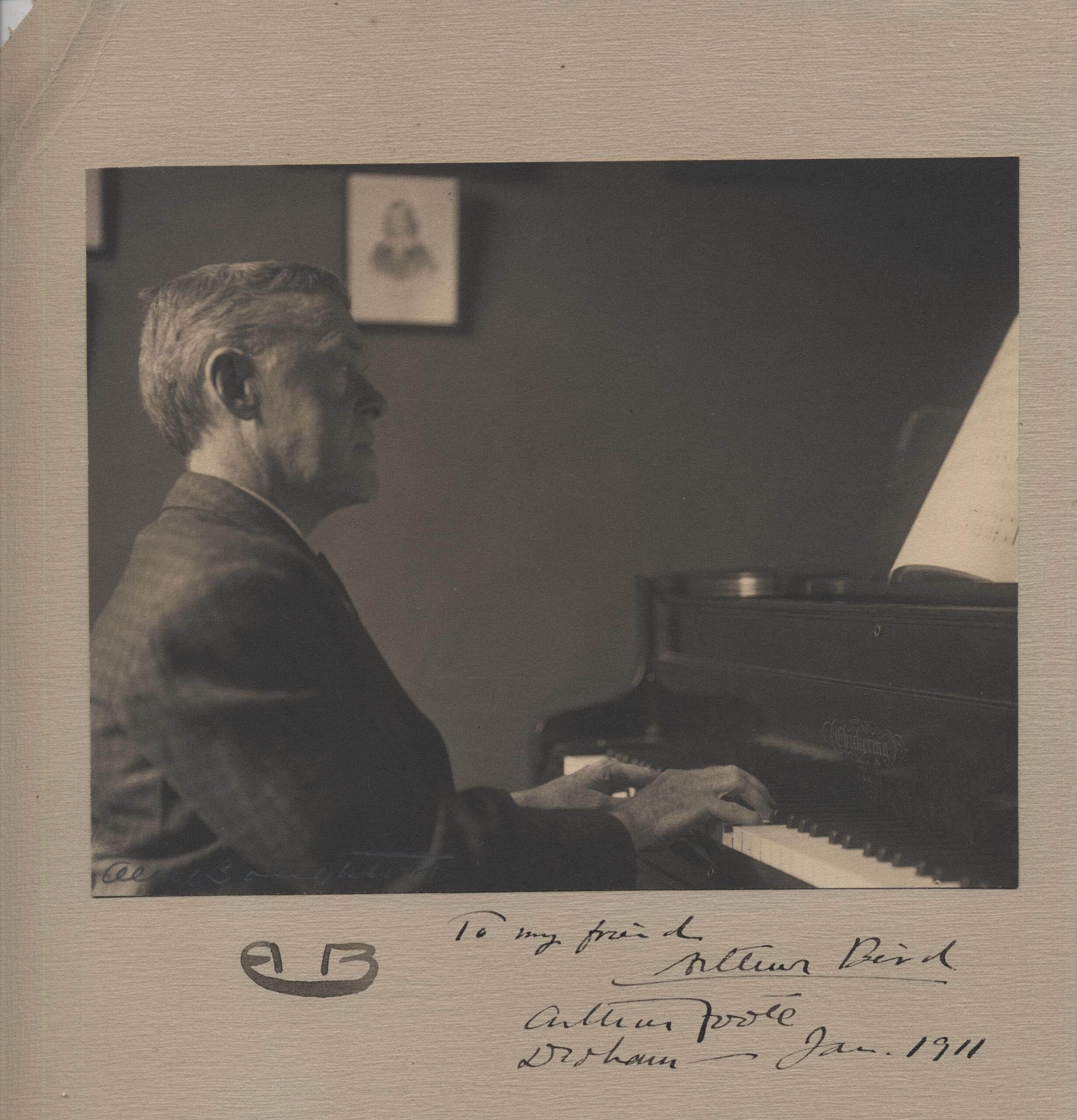Arthur Foote

Arthur William Foote, church musician and influential music teacher, was a leading member of a group of composers known as the Boston Six or the Second New England School.
Together, the Six -John Knowles Paine, Horatio Parker, George W. Chadwick, Edward MacDowell, Amy Beach, and Arthur Foote-wrote the first substantial body of “American” classical music. Foote was especially known for chamber music, art songs, and music for choirs.

Arthur Foote’s History
Arthur Foote was born on March 5,1853 in Salem, MA. His father, Caleb Foote, was the owner and editor of the Salem Gazette. Foote’s mother, Mary Wilder Foote, who passed away when Arthur was only four, was a devout Unitarian and a friend of the Emersons, Peabodys, Hoars, and Hawthornes.
In 1867 Foote went to Boston to study harmony with Stephan Emery at the newly founded New England Conservatory of Music, where he first began composing. In 1870, Foote went to Harvard to pursue further studies in music. He became conductor of the Harvard Glee Club and began studying composition with John Knowles Paine. In the summer of 1874, after graduating from Harvard, Foote returned to Salem, where he took up organ studies with B. J. Lang. Lang encouraged Foote to pursue music as a full time career and thus Foote returned to Harvard, where he received the very first Master of Arts degree in Music awarded by an American university.
In 1875, Foote opened a studio for teaching piano, which he continued for the next fifty years. A trip to the Wagner festival at Bayreuth in 1876 influenced some of Foote’s finest choral works including The Farewell of Hiawatha and The Wreck of the Hesperus. In the 1880s, Foote’s music became more widely known, with several of his works premiered by the Boston Symphony Orchestra including the tone poem In the Mountains, Suite for Strings in D major, Symphonic Prologue Francesca da Rimini, Suite in D minor, and Suite for Strings in E major.
In addition to composing, Foote became the organist for the First Unitarian Church in Boston, a position that he held until 1910. He also served on the faculty of New England Conservatory from 1921-1937, teaching piano and piano pedagogy. In addition to his teaching, Foote wrote several texts on the subjects of harmony and piano technique. From 1909-1912, Foote served as president of the American Guild of Organists as well as president of the Cecilia Society of Boston. Foote received honorary doctorates from Trinity College, CT and Dartmouth College. In 1913, Foote was elected to the National Institute of Arts and Letters.
Foote and Kate Grant Knowlton were married in 1880. They had one daughter Katharine Foote Raffy, who has been credited for talking her father into writing his autobiography late in life. Foote died in Boston on April 8, 1937 and is buried in Mt. Auburn Cemetery.
Hughes, Peter. “Arthur Foote.” Unitarian Universalist Historical Society.
(Accessed 4 December 2009) <http://www25.uua.org/uuhs/duub/articles/arthurfoote.html>
Composers. Foote, Arthur. Naxos. (Accessed 4 December 2009)
<http://www.naxos.com/composerinfo/arthur_foote/22849.htm>
Baker’s Biographical Dictionary of Musicians, 5th edition, completely revised by Nicholas Slonimsky. New York: G. Schirmer, 1971
Physical description
The Arthur Foote Papers
The Arthur Foote Papers consist of two scrapbooks. The first scrapbook consists of 52 pages (180 items of correspondence); the second scrapbook consists of 167 pages of clippings, programs, and memorabilia.
Note: Music manuscripts by Arthur Foote have been cataloged individually and can be found by searching our online catalog.
The first scrapbook was donated to the NEC Library on April 16, 1940 in memory of Arthur Foote. The second scrapbook was donated to the NEC Library in May 1974 by Gertrude Nissenbaum.
Access to the Arthur Foote Papers is granted by the Archivist. Appointments must be scheduled in advance. There are no restrictions pertaining to this collection.
Please contact the Archivist regarding copyright restrictions and publication permissions. This collection should be cited as: NECA 19.8. Arthur Foote Papers, New England Conservatory Archives, Boston, MA.
The first volume of this collection consists of one hundred eighty pieces of correspondence written to Arthur Foote during the years 1881-1922. The majority of letters date from the 1880s. There are several letters written by other members of the Second New England School, Amy Beach, Edward MacDowell. John Knowles Paine and Horatio Parker. Other correspondents include: Carl Baermann, William Gericke, George Grove, Victor Herbert, Henry Higginson, Helen Hopekirk, Julia Ward Howe, Franz Kneisel, Charles Loeffler, Ernst Perabo, Maud Powell, Josef Rheinberger, Clara K. Rogers, Templeton Strong, Theodore Thomas, Charles M. Widor, and Carl Zerrahn. For an inventory of the correspondence in this scrapbook, click here.
The second volume is a scrapbook of clippings, programs, memorabilia, and other items pertaining to Foote and his contemporaries, dating from 1873-1910. Included are programs of the Boston Cecilia, Handel and Haydn Society, and Harvard Musical Association, as well as various performances at Mechanics Hall, the Essex Institute, and Apollo Club meetings. Also of particular interest are: tickets to the premiere season (second performance) of Wagner’s Ring Cycle at Bayreuth from August 1876, with an additional flyer and reviews; the first issue of the Bayreuther Blätter from January 1878; programs containing passenger lists from steamship journeys from New York/Liverpool and Boston/Liverpool; and programs from various theaters in Britain including the Royal Theater, the Vaudeville Theater, Covent Garden, and the Globe Theater. For an inventory of the contents of this second scrapbook, click here.

